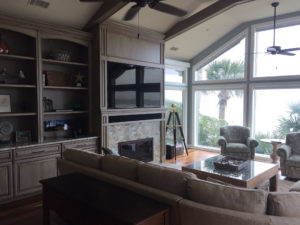Soundbar 101
Here is a helpful guide for all you need to know about soundbars. Maybe you want to have an elevated sound experience but aren’t ready to commit to a full surround sound system. Low and behold, the soundbar. We’ll break down the basics for you and from there, you can decide what type of soundbar is ideal for your living space.
So why buy a sound bar? Although the newest TVs seem to keep getting thinner and thinner; they’re improving in picture quality but compensating in sound quality with smaller and weaker drivers. Not to mention, the drivers are usually pointed down or away from the viewer. The sound is just as important as visual quality when it comes to your entertainment experience. You can’t just have one or the other, you need both. There’s nothing worse than having to rewind your show to figure out what you misheard because of diluted sound performance. Soundbars are typically used to enhance the sound of your TV, but can also be used as a speaker for music purposes as well.
Active or Passive?
There are two different types of soundbars: active and passive. Active soundbars come with a built-in amplifier and channel processors that separate the front, left, and right speakers in the soundbar. This is a simple and quick option if you don’t have a receiver laying around and requires fewer wires. A passive soundbar does not have a built-in amplifier and requires one in order to work. Although they require an amp, these are generally better in terms of sound quality. Keep in mind, you’ll also need a traditional subwoofer connection if you want that additional bass.
How Many Channels?
The soundbar channels are basically individual speakers sources within the soundbar. Let’s go over how many channels you can have.
- 2 channel soundbar” left and right (2 speakers)
- 3 channel soundbar: center, left, right (3 speakers)
- 5 channel soundbar: center, left, right, and two rear speakers(5 speakers)
- 7 channel soundbar: the same layout as the 5 channel soundbar except it splits the rear and surround channels into 4, thus, making 7 channels.
- Dolby Atmos Soundbar: the cream of the crop of soundbars. This comes in either a 5 or 7 channel format. These have upward firing speakers that reflect sound above you for a heightened 3D-like soundstage. This is perfect for rooms with high ceilings and hard, reflective surfaces.
I would recommend choosing a sound bar with at least 3 channels for the most immersive experience. Anything below that probably won’t be able to deliver that movie-like quality you’re looking for.
Location and Size
The location of your soundbar an important factor for your overall listening experience. This boils down to where your tv is placed and whether or not it has space around or underneath it. If you are planning on mounting your tv, it is best to place your soundbar directly below it. Sound experts recommend mounting your soundbar under the tv, rather than on top so the drivers are facing you at ear level. Some soundbars are even made for specific models of TVs. When it comes to size, a good rule of thumb is that your soundbar should not exceed the width of your tv. If you’re buying a new soundbar to connect to an older TV, be sure that your TV has the right inputs to hook up to, especially if your TV is 8 years or older.
Types of Connections
Your soundbar can be connected through a plethora of ways. Let’s go over some common areas of connectivity:
- HDMI ARC: Super easy and simple; connect to your TV’s audio return channel with an HDMI cable. This is perfect for multi-channel soundbars.
- Wireless: Care-free and Wire-free. You can connect wirelessly through Bluetooth via smartphone, computer, or tablet device. Or through Wifi by connecting to your home network and playing from any music streaming service like Spotify, Apple, Tidal, etc.
- Optical Port: Strong and Steady, an optical port is great for hosting a solid connection between your tv and soundbar. Although this is one of the most reliable connections, it does not have the bandwidth to carry over a 5.1 signal.
- USB Inputs: One of the less popular options, this isn’t used frequently unless you’re looking to plug in a thumb drive with your tunes on it.
Controlling Your Soundbar
In terms of controlling your soundbar, we have a few options. You can use the soundbar remote that comes with your device or program your existing TV remote to work with your soundbar. If you have a universal remote, you can also program your soundbar to connect with it along with everything else. Some soundbars even have mobile apps you can download for easy access through your smartphone or tablet device. Even better, you won’t even have to lift a finger with some of the latest soundbars that have voice assistance with Alexa and Google Assistant capability.
By: Wendy Wang




